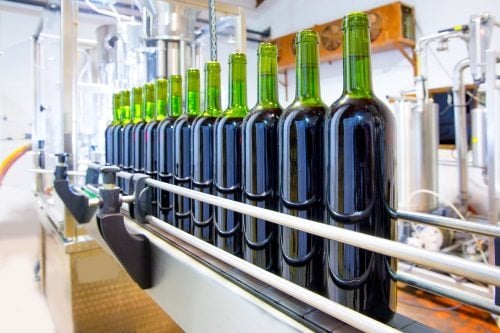For the first time, SIMEI@drinktec—the international exhibition for winery and bottling machinery—will take place as part of drinktec.
There will be more than 200 exhibitors showcasing machine technology and equipment for wine production and wine processing, including packaging solutions.
There will also be large exporting wineries and small winegrowers that mostly produce for regional demand.
SIMEI is an international trade fair for wine technology organized by Unione Italiana Vini.
Trends
In Europe, the wine’s origin plays a rather subordinate role for consumers, who put their full and complete trust in the brand, says the show organizer.
Global sourcing is thus gaining in significance in order to further reduce costs in this highly competitive market.
This gives new opportunities to winegrowers who have not yet been brought to the attention of the general public, for example the East, if they can provide the desired quality and quantity of bulk wine.
In the premium market, authenticity and sustainability are becoming increasingly important.
The central brand messages include keywords such as ‘wine culture’ and ‘tradition’.
However, for the customer, sustainability and environmental protection go hand in hand.
For example, to organic wine grape cultivation as well as to water or energy saving. As authenticity is popular, consumers’ first step in this direction could be native wines.
Native can mean ‘indigenous’ or ‘homegrown’—a native grape variety grows in the place where it originally existed.
Examples include the Elbling on the Moselle or the Grüner Veltliner throughout Austria.
This territorial uniqueness is a very promising unique selling point, particularly for consumers who want to deliberately rule out the global Chardonnays or Cabernets.
Niche wines
While orange wines and natural wines are a tiny niche, they are served in the hippest locations and most passionately discussed in social network forums.
In most cases, bio-organically or bio-dynamically operating businesses are behind ‘natural’ wines.
The wines are usually spontaneously fermented, i.e. without selected yeast.
They are also not sulfurized and filtered, or only to a slight degree.
As little technology as possible is the motto.
As a result, the white wines have a gold or even an orange shimmer to them.
Due to the high levels of tannin and lees they are slightly bitter and have herbaceous undertones.
Also, they have no or a very low amount of primary fruit aromas.
Craft spirits
While craft beer has already taken the global market by storm, craft spirits are now following suit in all their diversity.
Market researchers at Mintel find spirits have already increased their product launches worldwide by 265 percent between 2011 and 2015.
Christoph Witte, head of product management B2C at Döhler GmbH, states that many start-ups are also participating in the current market trends: “Alcoholic cold brew coffee specialties, innovation around the drink of the moment gin, or even the fusion of various symbiotic beverage categories—these are just a few examples of inspirations for alcoholic beverages, which we will be presenting at drinktec.”
Mintel shows that it is mainly generation Y, born between 1982 and 2000, which is stimulating the demand for craft spirits and craft cocktails.
Their brand loyalty is as small as their interest in entirely new countries of origin and experimental styles is great.
“A true pioneering spirit has broken out in the alcohol industry: classic spirits, wine, and sparkling wine are getting more and more unusual tastes through botanical extracts, exotic fruits, tea, coffee, and even vegetables,” says Witte.
Even champagne is part of this trend: Veuve Clicquot, who recently introduced really sweet champagnes, Rich and Rich Rosé, is seeking to penetrate the world of cocktails. Recommended ingredients for mixing with this include cucumber, celery, paprika, ginger, pineapple, hibiscus blossoms, and grapefruit zest.
The brand story
Millennials are interested in the story behind the brand.
The concept wines or signature wines of young winegrowers are therefore also the success story of recent years.
Instead of focusing on the place of origin, grape variety, or how the wine has been produced in communications, they let pictures, labels, and names speak for themselves and tell a story.
This fits perfectly into the social media age, in which the power of images is brought to our attention on a daily basis.
In general, social media tools such as Facebook, Twitter, apps, and blogs are becoming increasingly important in marketing.
Consumers look for information, tasting notes, recommendations, and ranking lists.
Online trade is also growing.
Compared to other industries, however, the traditional channels are still of central importance for wine.
According to a British study, for instance, the millennials view wine as a social drink, which they prefer to consume in bars or restaurants.
But even traditional trade has moved a long way down paths that lean on Internet search engines: In Holland, for example, merchants no longer arrange their wines according to the country of origin, but according to the taste and drinking occasion, making it easier for customers to find their perfect wine.
Of course, this idea can also be taken up by producers: a wine that began as a cuvée that goes well with asparagus could turn into an accompaniment to salmon or a delight to savor on a summer’s night.
New markets due to aging society
In 2050, about 28% of the European population is set to be 65 and older, up from 19% in 2015.
This aging society in Europe is opening up new markets for packaging solutions.
People are looking for smaller volumes and packaging that keeps the content fresh for longer.
The reason being that they like to drink wine regularly, but in smaller quantities.
These new packaging solutions can be made of glass, which still dominates the wine sector.
However, the opportunities for alternative packaging such as disposable PET or bag-in-box are getting better.












